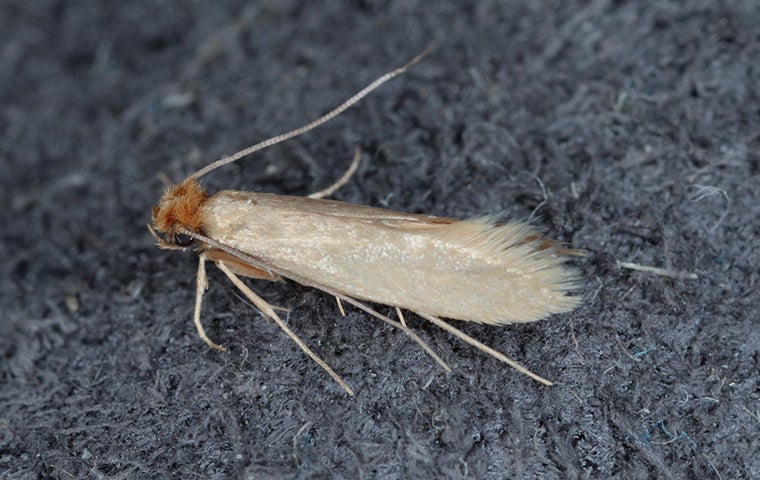What Are Clothing Moths?
As evident in their name, clothing moths are common Havertown pests known for damaging our clothes and other belongings made of fabric. They’re often mistaken for grain moths, which are a different type of pest known for infesting stored food items in kitchen pantries.
Clothing moths measure about ½ an inch long and are beige in color. They have narrow wings with small hairs on them, and they are weak flyers. Because they avoid light and quickly hide when disturbed, it can be hard to detect clothing moths, and you might not notice the problem until the damage is done.

Are Clothing Moths Dangerous?
Clothing moths feed on animal fibers, most notably wool, fur, silk, feathers, felt, mohair, cashmere, and leather. These pests digest a fibrous protein known as keratin, which can cause real harm to vulnerable materials. Clothing moths are known for causing damage to common fabric items like scarves, coats, sweaters, rugs, pillows, blankets, comforters, upholstery, etc.
Why Do I Have A Clothing Moth Problem?
If clothing moths are in your home, there are a couple of things to consider. Clothing moths are attracted to dark, humid spaces. They seek warm hiding spots near their food source, meaning dirty clothing crumpled up on the floor is more susceptible to an infestation than freshly laundered clothing that’s neatly hung in the closet.
Where Will I Find Clothing Moths?
As mentioned, clothing moths prefer dark corners and hidden cervices. They gravitate to mostly undisturbed areas, like remote closets, attics, and basements. You may find clothing moths in all sorts of places, such as:
- Inside the cracks of and around the outside of upholstered furniture.
- Vents and ducts that have lint debris and pet hair.
- In attics, chimneys, or wall cavities that have animal fibers and debris.
- The seams, folds, and creases of clothing like collars and cuffs.
- Around the edges of rugs and carpets and the outer edges of wall-to-wall carpets.
- Baseboards and floor and wall junctions.
If you discover any pest activity in these areas, it’s best to contact your local pest experts immediately. Cunningham Pest Control is here to address all your clothing moth control and prevention needs, so call today, and we’ll get started.
How Do I Get Rid Of Clothing Moths?
If you want to get rid of clothing moths in your home, there are certain ways you can be proactive in your prevention efforts. Here are some tips to get you starting in your clothing moth control efforts:
- After vacuuming, remove the vacuum bag and discard it outside right away.
- Clean around stored items inside closets and remote areas.
- Clean hair and lint out of heating vents and air ducts.
- Discard any old or infested items and thoroughly clean the clothes you keep.
- Monitor fabrics and closets for clothes moth activity and signs of damage.
- Store clothes made of wool, fur, or feathers in tightly sealed plastic storage bins.
- Use garment bags to hang up dresses and suits.
- Vacuum along and underneath rugs and carpets, along baseboards, and under furniture.
While taking precautionary measures to prevent clothing moths is helpful, it’s still not a guaranteed method of protection. The only 100% guaranteed form of clothing moth control is to secure professional home pest control and commercial pest control services.
How Can I Prevent Clothing Moths In The Future?
Dealing with clothing moths isn’t easy, and it’s not something you want to face on your own. The only guaranteed way to get rid of clothing moths and prevent them in the future is to reach out to the experts. Contact Cunningham Pest Control to discuss your clothing moth problems today. We’re here to help.
